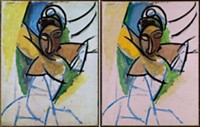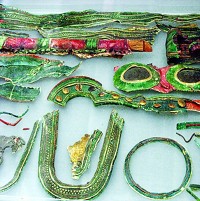Advertisement
Grab your lab coat. Let's get started
Welcome!
Welcome!
Create an account below to get 6 C&EN articles per month, receive newsletters and more - all free.
It seems this is your first time logging in online. Please enter the following information to continue.
As an ACS member you automatically get access to this site. All we need is few more details to create your reading experience.
Not you? Sign in with a different account.
Not you? Sign in with a different account.
ERROR 1
ERROR 1
ERROR 2
ERROR 2
ERROR 2
ERROR 2
ERROR 2
Password and Confirm password must match.
If you have an ACS member number, please enter it here so we can link this account to your membership. (optional)
ERROR 2
ACS values your privacy. By submitting your information, you are gaining access to C&EN and subscribing to our weekly newsletter. We use the information you provide to make your reading experience better, and we will never sell your data to third party members.
Nanomaterials
Getting Golden Tresses By Using Gold Itself
Nanoscience: Researchers use gold nanoparticles to dye hair
by Sarah Everts
November 15, 2012

Forget gold-plated teeth. Researchers have found a way to use the precious metal to dye human hair (Nano Lett., DOI: 10.1021/nl303107w).
As an added bonus for nightclub goers, the resulting golden hair also fluoresces red under blue light, says Philippe Walter, a chemist at the University of Pierre and Marie Curie, in Paris, who led the team that developed the dye technique.
This red fluorescence of the dyed hair stems from how the gold nanoparticles interact with the hair fibers, Walter explains. The nanoparticles bind to the sulfur in hair’s cysteine amino acids. Blue light excites electrons in the nanoparticles, which form what’s called a surface plasmon. This plasmon produces the red fluorescence, Walter says.
But the dyeing process may rein in the enthusiasm of those who seek golden locks: White strands of hair take seven hours of dyeing to acquire the first hint of a gold tint and 16 days to get the fluorescing red accent throughout the hair strand. (The researchers have not experimented much with darker hair.)
To boot, the dyeing process requires chloroauric acid (HAuCl4) and a very strong base with a pH of 12.5. That makes it more caustic than the classic alkaline hair perm, which requires ammonium thioglycolate and a pH of 9 or 10.
On the plus side, the amount of gold deposited in the hair is small, and so the dye is not prohibitively expensive, Walter says. The percentage by weight of gold in hair is about 0.4% or 0.5%, he says; the amount of gold in 100 g of hair, or an average head of long hair, would cost about $30.
This is not the first time researchers have used gold to dye a fiber. Last year, researchers in New Zealand reported dyeing merino wool with gold nanoparticles (Gold Bull., DOI: 10.1007/s13404-011-0012-y).
The difference between the two approaches, Walter says, is that the New Zealand group makes gold nanoparticles in advance and deposits them on the wool. Meanwhile, in the French group’s approach, hair acts as a scaffold on which gold nanoparticles form.
Michael Cortie, of the University of Technology, Sydney, in Australia, was unsurprised at the formation of the particles: “Gold nanoparticles will generally form whenever gold salts are brought into contact with organic material, whether skin, leaves, compounds, wool, fabric, bacteria,” he says.
Walter says he can imagine using gold-nanoparticled hair to detect toxic compounds in solution, since the presence of some toxic elements such as arsenic and mercury quenches the red fluorescence. He says he can also imagine using the hair as a platform to produce gold nanoparticles for other uses. However, extraction could be tricky because it would require dissolving the hair keratin, he says.
This is also not the first time Walter has explored nanoscience and hair dye. Back in 2006, Walter and his team recreated a 2000-year-old Roman recipe for black hair dye. They discovered that the coloring agent was lead sulfide nanocrystals, which darken human hair in the same way modern-day Grecian formula does (Nano Lett., DOI: 10.1021/nl061493u).





Join the conversation
Contact the reporter
Submit a Letter to the Editor for publication
Engage with us on Twitter